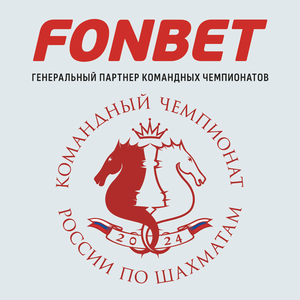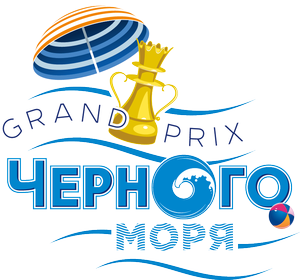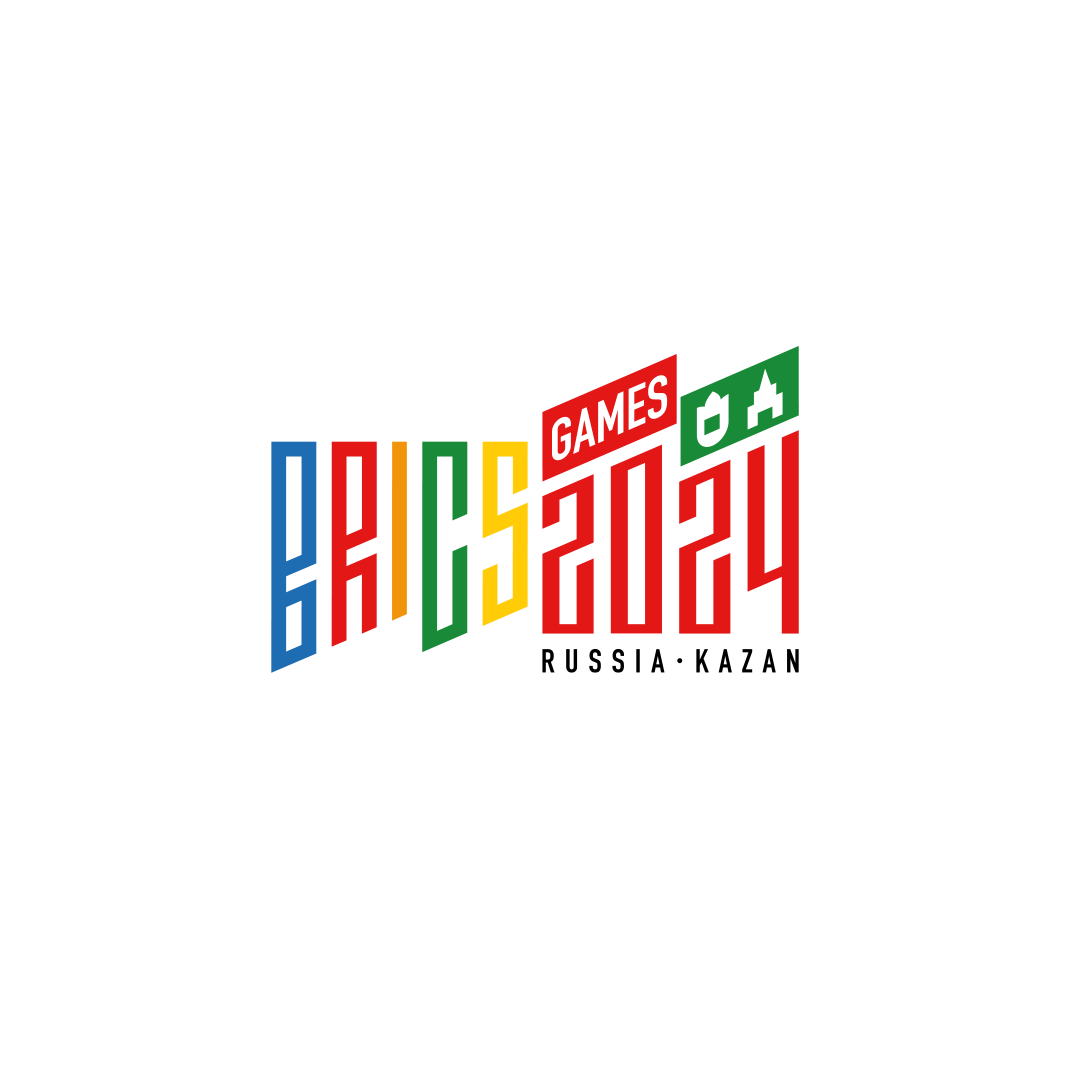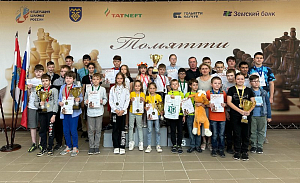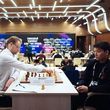Chess Burritos and Recipes by David Bronstein
The history of World Rapid Championships as described by Dmitry Kryavkin
Towards the end of December, the cultural capital of Russia hosts one of the most interesting and popular sporting tournaments of today- the World Rapid and Blitz Championship. The determination of chess leaders, FIDE President Arkady Dvorkovich, FIDE Director General Emil Sutovsky, the support of King of the Saudi Arabia Salman bin Abdulaziz Al Saud and the organisational capabilities of the Russian Chess Federation united in their desire to please chess players. This led to the creation of a prize fund that is one of the largest in history that was complemented by fairly relaxed criteria for participation. For the money that our dearly-beloved AGON takes for an hourly attendance of the world championship, one can spend five days beside Magnus Carlsen and, with extra luck, play against him.
InRussia? InStPetersburg? To tour St Isaac’s Cathedral before sitting at a board close the world champion? Those who are fortunate enough to experience this owe their thanks to the newly-created Global Strategy Commission for devising this formula of admission (2500 Elo points for men and 2200 for women in any one discipline and any rating lists in 2018)- I doubt the coming years will offer anything comparable to this. I will admit that I was one of the first to register. How could I lose this good fortune?
Carlsen, Aronian, Mamedyarov, Karjakin, Nepomniachtchi, Nakamura, Svidler, Giri, Fedoseev, Atremiev, Anand, Gelfand, Andreikin- two lines is barely sufficient to list all the stars who are eyeing the prize fund of a million dollars. Naturally, as well as the grandees, St Petersburg hosts tens of young talents and the aces of Russian speed tournaments that are headed by the main slayers of grand names Pavel Ponkratov and Dmitry Bocharov.
The battle will start in Manege Central Exhibition Hall on the 26thand until then we shall attempt to answer the following question: what number world rapid and blitz championship is this? The task is difficult, since our dear FIDE was led by a certain Gens Una Sumus for so many years that it will take our successors several centuries to decide which tournaments were official and which were not. Let us try to sort out this situation starting from the rapid chess.
1. Mazatlan, Mexico, 1988. An active champion and a passive champion
Towards the end of the 1980s, the aura of a new age began to change the classical structure of chess. Even the USSR hosted a grandiose open cup for rapid chess which brought together an astonishing group of chess players. FIDE went one step further and decided to hold a world championship for rapid chess, which they organised in an unusual spot: Mexico. The tournament was hosted by the association of hoteliers, who accommodated the players. The start was attended by 61 players: Anatoly Karpov, Rafael Vaganian, Jaan Ehlvest, Bent Larsen, Vladimir Tukmanov, Maxim Dlugy, Viktor Gavrikov, Walter Brown, Roman Dzhindzhihashvili, Leonid Yudasin, Maia Chiburdanidze, and the next best-rated player was Nana Ioseliani (2495).
After a Swiss tournament of 13 rounds, the top eight fought each other in a knockout system. In the end, the first place was contested between Anatoly Karpov and Viktor Gavrikov, who defeated Jaan Ehlvest and Vladimir Tukmanov in the semis respectively. The rigorous battle finished with a 5:5 draw, and Karpov was declared champion according to additional criteria and given the prize of 50,000 dollars.
Gavrikov-Karpov
Final
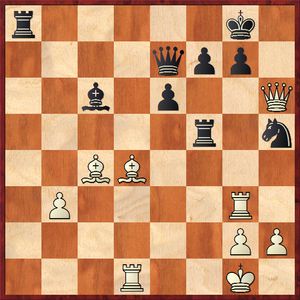
Karpov played 37...e5? instead of 37...f6, and White won after 38.Qхс6 Rd8 39.Rf3!
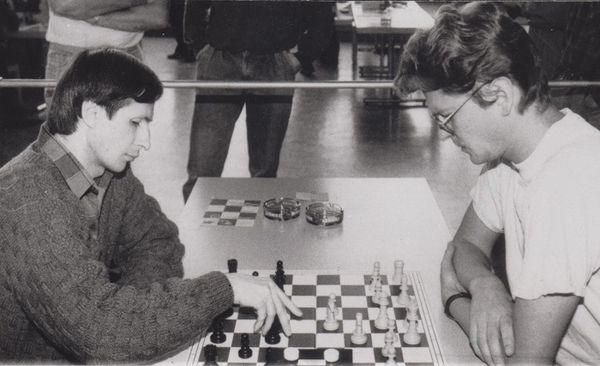
Karpov was declared the Active Chess Champion at the closing ceremony, which prompted Kasparov to point out the modest strength of his competitors and ask with irony: “So I am the “passive” chess champion?”
It should be pointed out that during the World Rapid championship in Spain, the match between USSR (Kasparov, Beliavsky, Gurevich, Psakhis, Chernin, Dolmatov, Azmaiparashvili) and the World Team (Ljubojevic, Korchnoi, Andersson, Spielmann, Portisch, Hjartarson, Nogueiras, Illescas) also took place- in rapid chess. The Soviet team narrowly beat their opponents; in the decisive match, Beliavsky literally mated Spielmann with a knight and bishop in the last seconds.
The sponsors liked the tournament and rapid chess was titled “chess burritos”, but another such tournament never took place. Alas, the chess world soon split apart. FIDE had no resources to host a rapid tournament, while Kasparov and the PSA hosted the Intel Grand Prix, without aiming to make it an official world championship while defending the tennis-cup formula for tournaments.
Some interesting facts.
The prize fund of the first World Rapid Championship was 150,000 dollars.
The tournament’s administrators made large donations to a fund aimed at curing children ill with HIV and AIDS.
The slogan for the world championships states that “This is the chess event of the year!” hinting at a break in the Kasparov-Karpov matches.
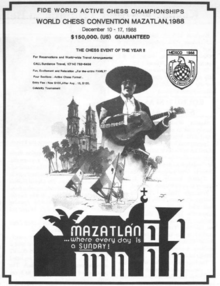
During the tournament, Anatoly Karpov’s chess school in Hollywood was presented, with American actors such as Erik Estrada, Henry Darrow, Gene Scherer (known for his roles of “bad Russians”) and Jessie Vint.
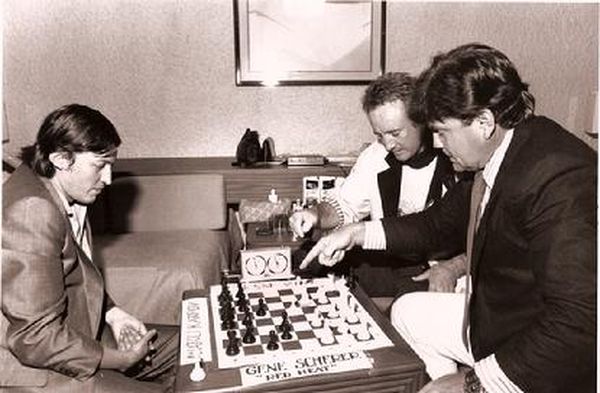
The press treated the tournament with extreme scepticism. The journals took turns to call the tournament “active”, which was usually followed by doubtful ruminations about the format.
Between the first and second
Meanwhile, the idea of rapid tournaments was quickly adopted by the organisers of festivals in the German city of Mainz, while the Amber super tournament awaited classics of rapid and blind chess. The only sticking point was Kasparov’s principled refusal to play in Monaco because he considered the tournament not serious, but he made an exception for the German event and won the 1999 tournament.
The first tournament before the return of a succession of rapid tournaments was the 2001 World Cup, which took place in Cannes. The tournament was organised by the French Chess Federation with FIDE support. 16 exceptional chess players were split into 4 groups and played according to a knockout system. The tournament lacked a few big names, as its rival in Monaco was played during the same dates. However, Garry Kasparov, the leader of the rating list, has consented to play in a FIDE tournament for the first time since the 1996 Olympiad. The tournament also employed a revolutionary Fischer control of 25 minutes per match with +10 seconds increment per each move.
In the final, Kasparov defeated Evgeny Bareev 1,5:0,5. The world champion’s opponent battled respectably, but could not find a salvation within seconds in a pawn ending.
A year later, this time under the auspices of Eurotel, a similar tournament took place in Prague. This time, all the strongest players were assembled: Kasparov, Kramnik, Anand, Topalov, Adams, Bareev, Morozevich, Ivanchuk, Gelfand, Khalifman, Grischuk, Karpov, Svidler. The only one missing was FIDE world champion Ruslan Ponomariov. This time, once again, 32 chess players appeared on the start line. Kasparov lost the quarterfinal match to Ivanchuk, while an elderly Karpov passed through Morozevich and Shirov before losing to Anand in the final.
2. Cap D’Agde (France), 2003. The rebirth of the tournament
The official world championship for rapid chess was resurrected in 2003. It was intended for the 12 highest-rated players (except Kasparov, who was refusing to play following the cancellation of his match against Ponomariov) to play in the tournament: the legendary Anatoly Karpov, European champion Zurab Azmaiparashvili, the two finest Frenchmen Etienne Bacrot and Joel Lautier. The tournament was organised by the Association of electricians and gas-workers of France with grand pomp along the Mediterranean coast. The tournament was promoted as the strongest rapid tournament in history, although the IntelGrandPrix tournaments would have disputed this claim, as Kasparov’s followers never tired of pointing out.
The players were split among 2 groups of 8 chess players, from where the best progressed into the quarterfinals. In the semis, Anand defeated Svilder and Kramnik defeated Grischuk. The final ended with the victory of the Indian grandmaster, who became the new world champion in rapid chess.
Leko-Anand
Group B
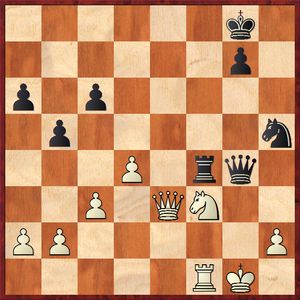
After 37.Kf3 the white king is out of danger, but the Hungarian missed a blow 37.Kh1? Ng3+! 38.hхg3 Qh3+ 39.Kg1 Qхg3+ 40.Kh1 Rh4+ winning both the queen and the game.
Some interesting facts.
The tournament was attended by the main promoter of rapid chess in the 20th century, David Bronstein, who appeared alongside the oldest grandmasters in the world, Andre Lilienthal and Mark Taimanov. In his speech at the closing ceremony, David Bronstein pointed out that this was a fulfillment of his decades-old dream.
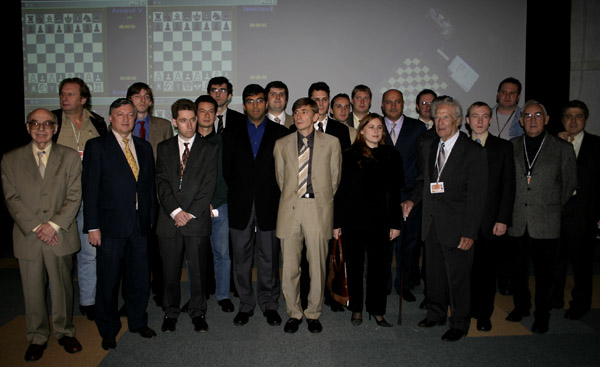
ACP Cups
During the wave of discontent towards the leaders of chess finance policy in the 2000s, a number of grandmasters formed the Association of Chess Professionals (ACP), which, aside from defending players’ rights, was tasked with hosting World Rapid Championships.
The finals took place in Odessa thanks to the sponsorship of Pivdenniy Bank. The bank’s founder, Vadim Morokhovskiy, played a large role in the ACP. Most of the finalists were picked from the tournament of ACP series. FIDE President Ilyumzhinov was present at the opening of the first tournament, where he signed an agreement with PCA that gave FIDE’s blessing for the tournament to call itself the official World Cup.
The tournament was hosted for four years.
2007. Odessa. Final. Peter Leko defeated Vassily Ivanchuk.
2008. Odessa. Final. Teimour Radjabov defeated Alexander Grischuk.
2009. Odessa. Boris Gelfand defeated Peter Svidler.
2010. Odessa. Sergey Karjakin defeated Dmitry Jakovenko. The winner was decided by Armageddon for the first time.
Three years later, Alexei Shirov and the head of the ACP Emil Sutovsky attempted to resurrect the Cup, and the final was hosted in Riga. AlexanderGrischukdefeatedIanNepomniachtchi.
3. Astana (Kazakhstan), 2012. A race between historic opponents
At the closing ceremony of the 2003 tournament, the officials promised to make the tournament permanent, but promises are sometimes carried out many years later. In this case, the next tournament was played ten years later, in 2012. Ten chess players were picked because of their ratings, local players and FIDE nominees received three wild-cards and three qualified from a mass qualification group. The control over timing was reduced from 25 to 15 minutes for “greater visual drama”.
The final tournament was defined by a race between two leaders of the younger generation, Magnus Carlsen and Sergey Karjakin. Having won the individual game, the Norwegian was ahead of his opponent by 1,5 points, but here the fate of the tournament was changed by Vassily Ivanchuk, who defeated Carlsen (just like at the end of the Candidates Tournament in London) before dropping the ball against Karjakin! Magnus “went”: he lost to Grischuk, was almost beaten by Topalov and finished second to Sergey.
Karjakin – Ivanchuk
Round 11
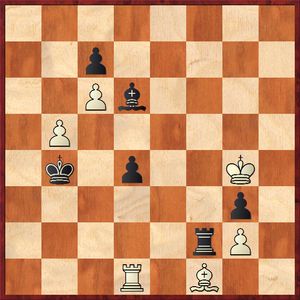
Black to move. A future «Minster of Defence» biuilt a solid fortress. Ivanchuk lost on time while thinking on how to destroy it!
Nevertheless, Carlsen was in a good mood at the press press conference and congratulated a new world champion on a well-deserved victory.
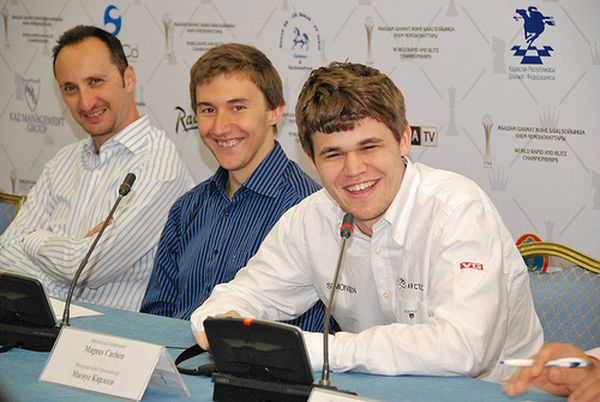
Results: 1. Karjakin – 11.5 points out of 15, 2. Carlsen – 10.5, 3. Topalov, 4. Mamedyarov – 9.5.
Some interesting facts.
There was a small historical confusion and the media claimed that the World Rapid Championship was organised for the first time in Kazakhstan, which caused protests on behalf of former champions.
In the qualifying tournament, the Appeals Committee sprang into action and approved Nikolai Chadaev’s protest on his match against Vladislav Tkachev (the fixation of a draw due to the rule of 50 moves).
Karjakin was almost late for the tournament: his flight from Simferopol to Moscow was delayed, and he had to take another flight to Astana.
The prize fund was 240,000 dollars.
4. Khanty-Mansiysk (Russia), 2013. The champion hopes for weaknesses
The first tournament to be played with the current (Swiss-style) formula was in Khanty-Mansiysk. For the first time, players with ratings of 2500 and above were admitted, although the prize fund decreased by 40,000 dollars since 2012. These 200,000 dollars became the usual sum for a long time. Some elite chess players (like Carlsen and Anand, who were preparing for the World Championship Match) did not show up, but the quality of attendees was still high. The match was attended by 60 players.
Ian Nepomniatchi led the tournament for a long time, but he decreased his intensity in the last day, which presented an opening for his competitor Shakhriyar Mamedyarov, who won 5 points out of 5 towards the finish. Third place after Mamedyarov and Nepomniatchi was occupied by Alexander Grischuk.
Nepomniachtchi – Mamedyarov
Round 7
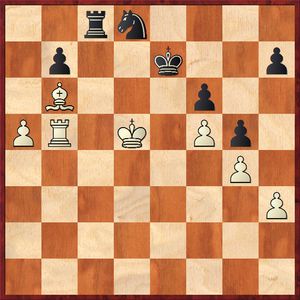
Ian’s consolation was his technical victory over the champion in their game: 53.Bхd8+! Rхd8+ 54.Kc5 Rd7 55. Rb6 Rc7+ 56.Kb5 Kf7 57.Rd6, white king moved to b6, while black pawn b7 fell.
1. Mamedyarov - 12,5 outof15, 2. Nepomniatchi - 11,5, 3.Grischuk - 11.
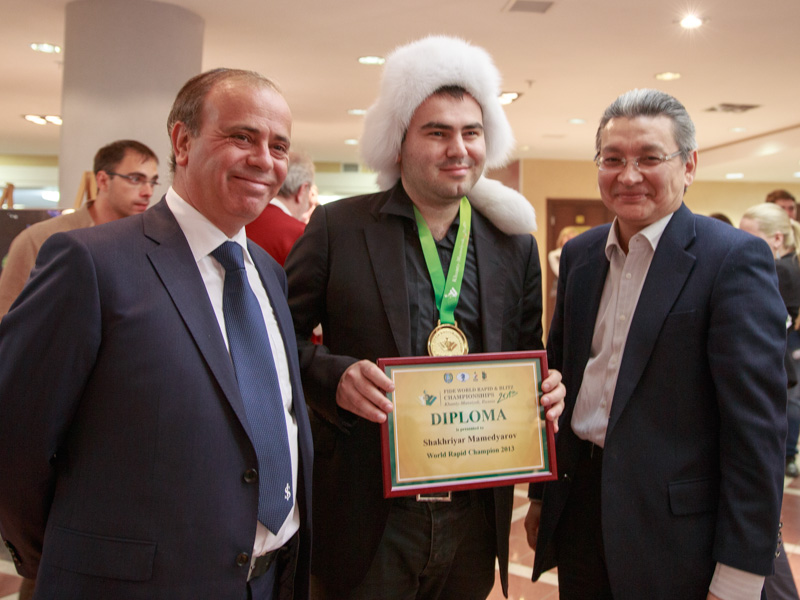
Some interesting facts.
For the first time in such tournaments, the coverage and commentary were organised online by Sergey Shipov and Mark Glukhovskiy (a year earlier, Shipov led the commentary on the championship in Kazakhstan, but only for the viewers of his site crestbook.com).
During the press conference, Mamedyarov, who won the most points in the history of the World Rapid Championships, stated that he hoped his status of champion will lead to a relaxation of punishments from Baku’s traffic policemen.
5. Dubai (UAE), 2014. Absolute champion.
The Emirates, sands and sheikhs- 109 people came to play rapid chess in the East, which was a new record for the number of competitors. The tournament went particularly well for Fabiano Caruana, who already had a reputation of a player with little regard for rapid chess long before the world championship in London. Carlsen suffered a heavy blow from the match examiner Vishy Anand, but the determined Viking still won first place.
1.Carlsen - 11 out of 15, 2. Caruana, 3. Anand, 4. Aronian, 5. Morozevich - 10,5 each.
Carlsen – Grischuk
Round 14
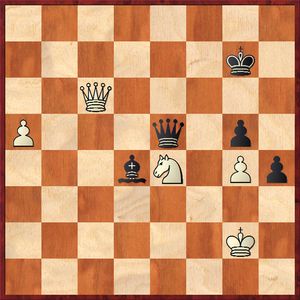
The most decisive game of the tournament. Alexander was winning, then he could make a draw by a study-like 53...Bc5!!, but finally White traded queens and took the rival's bishop in exchange for the passer “a”.
Some interesting facts.
After his double victory in Dubai, Magnus Carlsen achieved a unique accolade- he became a world champion in three disciplines: classical, rapid and blitz chess.
The rating favourite before the start was Hikaru Nakamura. After winning and adding multiple points, Carlsen uttered his famous statement that leadership in the rating lists list meant as much to him as the title.
For a part of the tournament, the Norwegian discarded the standard jacket with the sponsors’ logo and wore the uniform of Real Madrid.
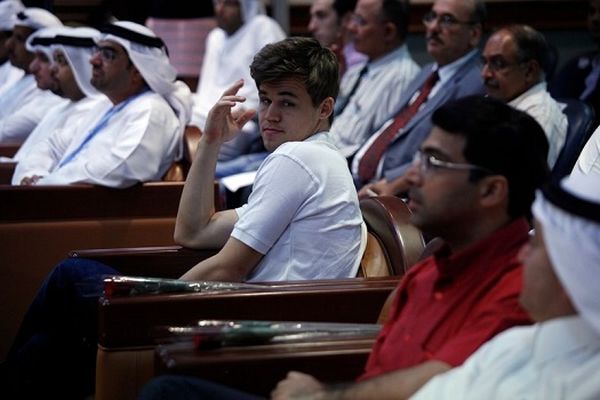
But sometimes he just turned up in the t-shirt
6. Berlin (Germany), 2015. The favourites and disruptors of peace
For the first time, the tournament was hosted in a European capital, and the number of competitors increased to 158. For the first time, the tournament was played during the autumn instead of the first few weeks of the summer. But from 2016 onwards, the rapid and blitz world championships were held in December.
This time, there was none of the usual competition among the leaders of the rating list: many of the favourites were unexpectedly vanquished by their lesser renowned colleagues. Five rounds until the finish, the main challenge to Carlsen came from Sergey Zhigalko and Igor Kovalenko, but they didn’t end up making it into the top 3.
Carlsen scored 11,5 points out of 15, with Nepomniatchi, Radjabov and Dominguez finishing a point behind. Fifth place unexpectedly went to Dmitry Bocharov- it is hard to remember an instance when a non-elite player finished so high in such a tournament.
During the final press-conference, Carlsen shared some of his secrets for success: “It is important not to let current results affect you and you should not be scared of playing draws in a tournament of 15 rounds!”
Carlsen – Dubov
Round 6
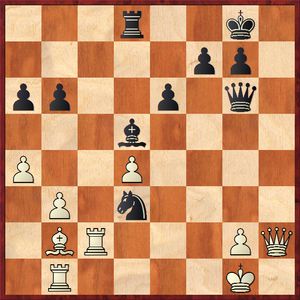
It all wouldn’t have been so easy for Magnus, had Daniil Dubod played 33...Ne5. Wouldn’t a current result affect him?
Some interesting facts.
The tournament in Berlin was organised by AGON, and for the first time with an entry cost money- 9 euros per day.
Magnus played all matches at the same table that was reserved for him, since his games were broadcast by Norwegian TV and other outlets.
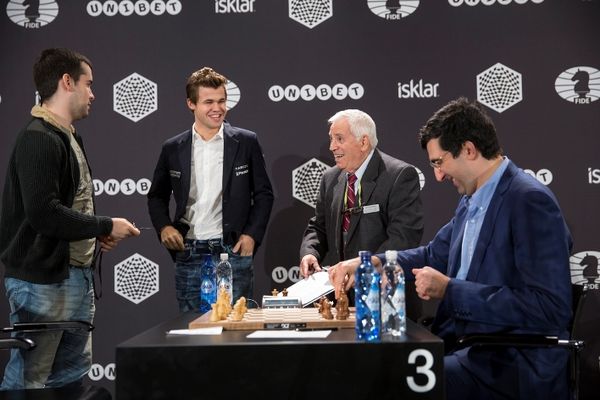
Vladimir Kramnik did not win a prize, but neither did he lose a single match- the only one to do so beside Carlsen.
7.Doha (Qatar), 2016. Equal rights
In 2016, another convention of chess players in the East equalised the rights of male and female representatives. After all, it was the ACP women’s 2012 world championship which launched the era of democratic Swiss-style tournaments.
However, although 106 men signed up for the tournament, only 34 women joined them. The men’s prize fund totalled the usual 200,000 dollars, while the women’s was 40,000. The main sensation of the tournament was Vassily Ivanchuk- the Ukrainian genius outplayed Carlsen and came first. The same number of points (11 out of 15) was won by Alexander Grischuk and Magnus Carlsen, but Ivanchuk came first thanks to additional criteria.
“Ivanchuk has been among the elite for three decades and he deserved this victory. He played very well against me and defeated me convincingly. If he played all of his matches with half the strength that he shows against me…”, said Magnus Carlsen.
Ivanchuk – Carlsen
Round 7

Some interesting facts.
During the closing ceremony, a crowd gathered around Vassily Ivanchuk, who was solving checkers puzzles with Baadur Jobava. The organizers who stood with the champion’s gold medal had to call him several times to tear him away from his favourite pastime. But even when he stood on the pedestal, Ivanchuk continued to solve puzzles in his head.
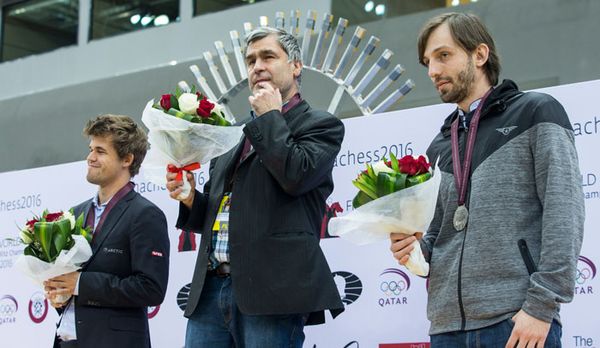
8. Riyadh (Saudi Arabia), 2017. Golden mountains and protests
FIDE was undergoing a difficult period- sanctions, a chiasmus in government, closing of accounts. The silver lining was the partnership between the Saudi royal family and the General Sports Authority, who decided to organise a tournament in their capital with an unprecedented prize fund- a million dollars for both rapid and blitz (750,000 for men and 250,000 for women)
The organizers sharpened the criteria for entry (2600 and above for men), but admitted a larger number of invited players. According to reviews, this was the best organized tournament in history.
Nonetheless, a bitter controversy reared its head. The Saudis did not allow Israelis or Iranians to participate, and the media was subsumed with discussion of this decision, and whether the female chess players would be allowed to appear without the traditional hijab and Abaya. The ACP criticised FIDE’s decision to host the tournament in Riyadh, a number of leading players boycotted the tournament and Hikaru Nakamura joined Anna Muzychuk in a public denunciation of this decision. Carlsen showed up but promised he wouldn’t play in 2018 if all players were not afforded equal rights.
Nonetheless, 134 men and 100 women came to Saudi Arabia. First place was won by Anand, who finished without a single defeat and came first ahead of Fedoseev and Nepomniachtchi thanks to additional criteria. According to the rules of the tournament, the first two had to play a match to decide the gold medal, and Anand beat Fedoseev 1,5:0,5.
Six sportsmen finished a half-point behind, including Magnus Carlsen.
Carlsen – Anand
Round 9
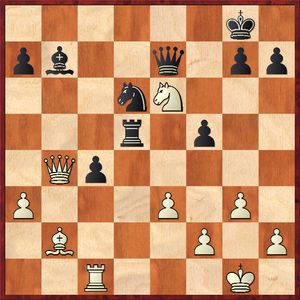
It is impossible to win the World Championship without defeating Magnus Carlsen! Instead of retreating to f4, Carlsen slipped 33.Nc5?? Rхс5 34.Qхс5 Qe4 destroying the white king or queen (of the monarch runs to d2).
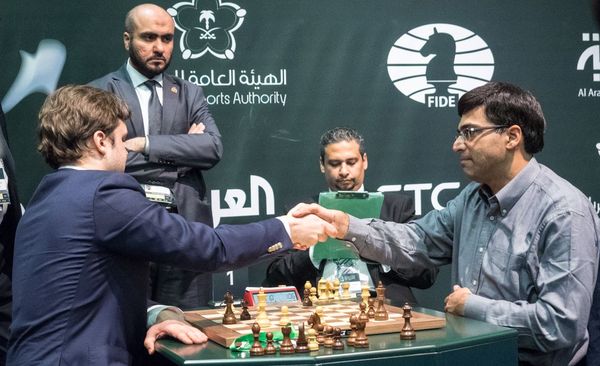
Some interesting facts.
To win the tournament, Anand had to win 6 games and draw 9. In two of his draws, the games went on for longer than 30 moves (33 moves against Ponkratov and Onischuk), while in the final match against Bu Xiangzhi, the champion agreed to a draw after 11 moves.
So, we can compose a small history of champions. 1988- Karpov, 2003- Anand, 2012-Karjakin, 2013- Mamedjarov, 2014 and 2015- Carlsen, 2016- Ivanchuk, 2017-Anand. A fine list!
Photos by Maria Emelianova, Anastasia Karlovich, and Chessbase.com









